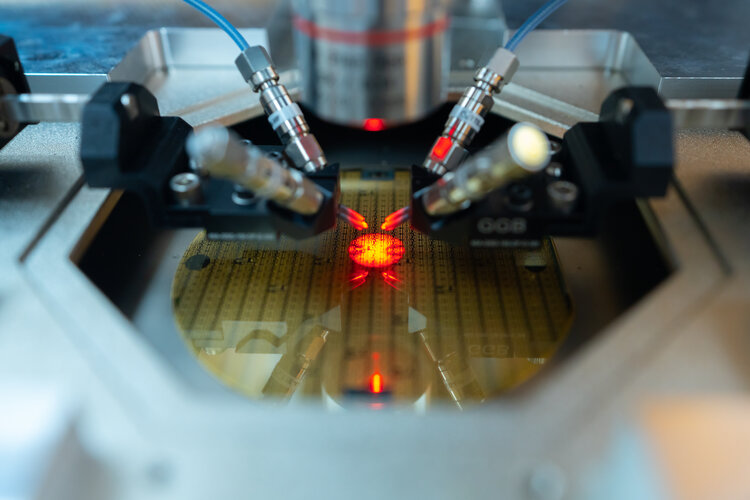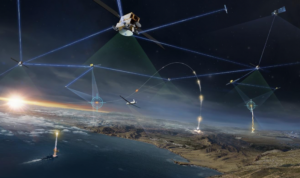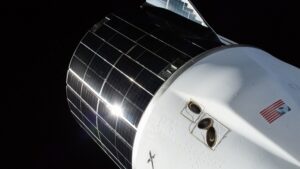Going GaN: novel chips powering space missions
Tuesday, 14 June 2022 13:03
Some of ESA’s most ambitious future missions for telecommunications and Earth observation have only become possible because of a switch to a novel high-power and high-temperature capable semiconductor – sometimes termed the most promising material since silicon. ESA laboratory testing has confirmed the performance of key European-made Gallium Nitride components.
Northrop Grumman demonstrates Mynaric laser terminals for military constellation
Tuesday, 14 June 2022 12:30
Using Mynaric terminals,, Northrop Grumman conducted a ground demonstration of optical communications for the U.S. Space Development Agency's low Earth orbit constellation
The post Northrop Grumman demonstrates Mynaric laser terminals for military constellation appeared first on SpaceNews.
Watch the ESA Council information session
Tuesday, 14 June 2022 12:30
The media information session following the 308th ESA Council will be streamed on 15 June from 12:40 to 13:15 CEST at esawebtv.esa.int. Join us to hear more about the cooperation between ESA and NASA.
Airbus-built Earth observation satellite SARah-1 ready for launch
Tuesday, 14 June 2022 11:35 The Airbus-built "SARah-1" Earth observation satellite, under subcontract to OHB System AG, has been transported from Friedrichshafen, Germany, to Vandenberg, California, USA, and is currently being prepared for launch in June 2022 and subsequent operation by Airbus in space.
SARah is a new operational reconnaissance system consisting of several satellites and a ground segment, which was d
The Airbus-built "SARah-1" Earth observation satellite, under subcontract to OHB System AG, has been transported from Friedrichshafen, Germany, to Vandenberg, California, USA, and is currently being prepared for launch in June 2022 and subsequent operation by Airbus in space.
SARah is a new operational reconnaissance system consisting of several satellites and a ground segment, which was d ReOrbit and VENG signs agreement for satellite manufacturing
Tuesday, 14 June 2022 11:35 ReOrbit and VENG, an Argentinian-based company, signed an agreement to manufacture satellites in Argentina to serve the Latin America market. The directors of both organisations met at the Argentina Space Centre located in Cordoba Province, Argentina, to visit the VENG's AI&T facilities, discuss future collaborations and finally sign a Memorandum of Understanding.
VENG, the main contractor
ReOrbit and VENG, an Argentinian-based company, signed an agreement to manufacture satellites in Argentina to serve the Latin America market. The directors of both organisations met at the Argentina Space Centre located in Cordoba Province, Argentina, to visit the VENG's AI&T facilities, discuss future collaborations and finally sign a Memorandum of Understanding.
VENG, the main contractor Unravelling the mysteries of clouds
Tuesday, 14 June 2022 11:35 Clouds and aerosols are still considered the great unknowns in understanding our climate. With the EarthCARE Earth observation satellite, Airbus has made the finishing touches to the crucial 'key' that will unlock the mysteries of clouds, helping make more accurate atmospheric models and climate forecasts.
The 2.3-tonne satellite is now being transported from the Airbus site in Friedrichsh
Clouds and aerosols are still considered the great unknowns in understanding our climate. With the EarthCARE Earth observation satellite, Airbus has made the finishing touches to the crucial 'key' that will unlock the mysteries of clouds, helping make more accurate atmospheric models and climate forecasts.
The 2.3-tonne satellite is now being transported from the Airbus site in Friedrichsh Isar Aerospace and EXOTRAIL partner on cloud-based simulation software ExoOPSTM
Tuesday, 14 June 2022 11:35 The launch service provider Isar Aerospace signs in as the latest ExoOPSTM - Mission Design customer, Exotrail's Software-as-a-Service (SaaS) solution dedicated to space mission simulation and analysis.
Isar Aerospace, the leading European launch service provider focusing on small and medium satellite deployment, will use ExoOPSTM - Mission Design to answer the thriving demand for flexible
The launch service provider Isar Aerospace signs in as the latest ExoOPSTM - Mission Design customer, Exotrail's Software-as-a-Service (SaaS) solution dedicated to space mission simulation and analysis.
Isar Aerospace, the leading European launch service provider focusing on small and medium satellite deployment, will use ExoOPSTM - Mission Design to answer the thriving demand for flexible Studying grassland from space
Tuesday, 14 June 2022 11:35 The Sentinel-2 space mission began with the launch of Earth observation satellite Sentinel-2A in June 2015, and Sentinel-2B was launched in March 2017. Since then, these two satellites have been orbiting in space at an altitude of nearly 800 kilometres and, as part of ESA's Copernicus programme, providing data for, e.g., climate protection and land monitoring.
very three to five days, they
The Sentinel-2 space mission began with the launch of Earth observation satellite Sentinel-2A in June 2015, and Sentinel-2B was launched in March 2017. Since then, these two satellites have been orbiting in space at an altitude of nearly 800 kilometres and, as part of ESA's Copernicus programme, providing data for, e.g., climate protection and land monitoring.
very three to five days, they Earth's magnetic poles not about to flip
Tuesday, 14 June 2022 11:35 The emergence of a mysterious area in the South Atlantic where the geomagnetic field strength is decreasing rapidly, has led to speculation that Earth is heading towards a magnetic polarity reversal. However, a new study that pieces together evidence stretching back 9,000 years, suggests that the current changes aren't unique, and that a reversal may not be in the cards after all. The study is p
The emergence of a mysterious area in the South Atlantic where the geomagnetic field strength is decreasing rapidly, has led to speculation that Earth is heading towards a magnetic polarity reversal. However, a new study that pieces together evidence stretching back 9,000 years, suggests that the current changes aren't unique, and that a reversal may not be in the cards after all. The study is p New feedback system can improve efficiency of fusion reactions
Tuesday, 14 June 2022 11:35 Scientists at the U.S. Department of Energy's (DOE) Princeton Plasma Physics Laboratory (PPPL) have refined the use of magnetic fields to improve the performance of doughnut-shaped fusion facilities known as tokamaks. The improved technique protects internal parts from damage by instabilities called "edge-localized modes" (ELMs) and allows tokamaks to operate for longer without pausing.
"O
Scientists at the U.S. Department of Energy's (DOE) Princeton Plasma Physics Laboratory (PPPL) have refined the use of magnetic fields to improve the performance of doughnut-shaped fusion facilities known as tokamaks. The improved technique protects internal parts from damage by instabilities called "edge-localized modes" (ELMs) and allows tokamaks to operate for longer without pausing.
"O Difficult-to-observe effect confirms the existence of quark mass
Tuesday, 14 June 2022 11:35 A phenomenon that directly proves the existence of quark mass has been observed for the first time in extremely energetic collisions of lead nuclei. A team of physicists working on the ALICE detector at the Large Hadron Collider can boast this spectacular achievement - the observation of the dead cone effect.
The objects that make up our physical everyday life can have many different prope
A phenomenon that directly proves the existence of quark mass has been observed for the first time in extremely energetic collisions of lead nuclei. A team of physicists working on the ALICE detector at the Large Hadron Collider can boast this spectacular achievement - the observation of the dead cone effect.
The objects that make up our physical everyday life can have many different prope Cargo Dragon launch rescheduled for July after identifying hydrazine leak
Tuesday, 14 June 2022 10:18
A SpaceX cargo Dragon mission to the International Space Station will now launch no earlier than July 11, a delay of more than a month after engineers identified the source of elevated hydrazine readings in the spacecraft.
SpaceX closer to launching giant rocketship after FAA review
Tuesday, 14 June 2022 07:21
SpaceX cleared a key hurdle Monday for its plan to launch a gigantic, futuristic rocketship into orbit from Texas.
The Federal Aviation Administration concluded an environmental review of Elon Musk's Starship base. The agency saw no significant environmental concerns, but is requiring more than 75 actions to reduce impacts to the region.
It's no guarantee a launch license will be issued since other factors such as safety and financial responsibility requirements still must be met at the Boca Chica site, according to the FAA.
After the latest news, SpaceX tweeted: "One step closer to the first orbital flight test of Starship."
At nearly 400 feet (120 meters), Starship is the most powerful rocket ever built and meant to carry people to the moon and Mars. NASA intends to use it for the space agency's lunar landing of astronauts, planned no earlier than 2025.
While SpaceX has launched Starship's bullet-shaped upper stage several miles (10 kilometers) into the air over the past year—resulting in some spectacular explosions—it's yet to fly it atop a Super Heavy booster.
Some residents had opposed Starship launches and landings, citing not only the noise and closed roads, but also wreckage raining down from failed flights.
Chinese university completes space-based solar power ground test facility
Tuesday, 14 June 2022 07:14
China's Xidian University has completed what it calls the world’s first full-link and full-system ground test system for space-based solar power.
Space takes centre stage at VivaTech
Tuesday, 14 June 2022 07:12
How does ESA enable the European space industry to prosper in the global market? People attending this week’s VivaTech show in Paris – which will showcase how innovation and technology can build a more sustainable and inclusive society – will discover how.

